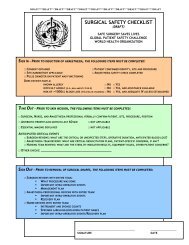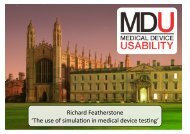The Essentials of Patient Safety - Clinical Human Factors Group
The Essentials of Patient Safety - Clinical Human Factors Group
The Essentials of Patient Safety - Clinical Human Factors Group
You also want an ePaper? Increase the reach of your titles
YUMPU automatically turns print PDFs into web optimized ePapers that Google loves.
<strong>The</strong> <strong>Essentials</strong> <strong>of</strong> <strong>Patient</strong> <strong>Safety</strong><br />
Many adverse drug events occur outside hospital, <strong>of</strong>ten then leading to<br />
hospital admission. For instance, in Boston Tejal Gandhi and colleagues reviewed 661<br />
out patients on a variety <strong>of</strong> drug regimens (10). Incredibly, almost a quarter <strong>of</strong> these<br />
people were assessed as suffering adverse drug reactions and about 6% <strong>of</strong> the patients<br />
were suffering serious reactions. Serious adverse drug reactions included bradycardia,<br />
hypotension and gastrointestinal bleeding, many <strong>of</strong> which were clearly preventable.<br />
Other consequences were less serious, in that they did not present immediate threats<br />
to life, but were certainly serious for the patient. For instance, one patient suffered<br />
prolonged sexual dysfunction after his doctor failed to stop a selective serotonin<br />
uptake inhibitor; another had continued sleep disturbance due to taking an antidepressant<br />
that his doctor was not aware <strong>of</strong>. Such reactions represent prolonged,<br />
avoidable suffering over many months, to say nothing <strong>of</strong> the waste <strong>of</strong> time and<br />
resources.<br />
<strong>The</strong> impact and cost <strong>of</strong> adverse events<br />
<strong>The</strong> majority <strong>of</strong> adverse events, about 70% in most studies, do not have serious<br />
consequences for the patient; the effects <strong>of</strong> minor events may be more economic, in<br />
the sense <strong>of</strong> wasted time and resources, than clinical (6). Some, such as the reaction<br />
to anaesthetic, are not serious for the patient but are classed as an adverse event<br />
because there was an increased stay in hospital <strong>of</strong> one day; it was probably not<br />
preventable in that it would have been hard to predict such an idiosyncratic reaction.<br />
Others however, as the remaining examples show, cause considerable unnecessary<br />
suffering and extended time in hospital.<br />
In Britain the cost <strong>of</strong> preventable adverse events is £1 billion per annum in lost<br />
bed days alone as, on average, an adverse event leads to an extra week in hospital<br />
(11). <strong>The</strong> Institute <strong>of</strong> Medicine report (1999) was able to estimate that in the United<br />
States the total national costs associated with adverse events and preventable adverse<br />
events represent approximately 4% and 2% respectively <strong>of</strong> national health<br />
expenditure (12). Costs <strong>of</strong> direct hospital care, essentially additional time in hospital,<br />
have recently been estimated from the Dutch adverse events study finding that about<br />
3% <strong>of</strong> all bed days and 1% <strong>of</strong> the total health budget could be attributed to<br />
preventable adverse events (13). <strong>The</strong> real overall costs are probably a good deal<br />
higher, as these estimates do not include additional treatments and investigations or<br />
any <strong>of</strong> the associated societal costs discussed above. Remember also that these<br />
estimates are confined to the hospital sector; we have no idea <strong>of</strong> the additional costs<br />
<strong>of</strong> adverse events in primary care or mental health.<br />
<strong>The</strong> human cost <strong>of</strong> adverse events is the greatest <strong>of</strong> all. Many patients suffer<br />
increased pain and disability from serious adverse events. <strong>The</strong>y <strong>of</strong>ten also suffer<br />
psychological trauma and may experience failures in their treatment as a terrible betrayal<br />
<strong>of</strong> trust. Staff may experience shame, guilt and depression after making a mistake with<br />
litigation and complaints imposing an additional burden (14). <strong>The</strong>se pr<strong>of</strong>oundly<br />
important aspects <strong>of</strong> patient safety, generally given far too little attention, are considered<br />
later.<br />
Vulnerability to harm: the old and the frail<br />
Curiously, relatively little attention has been paid to patient safety in older people<br />
although they are particularly vulnerable to healthcare error and harm, as are the very<br />
young (15). Most people in hospital are old. In Britain for instance patients over 65,<br />
mostly with multiple long term conditions, account for about 60% <strong>of</strong> admissions and<br />
13








